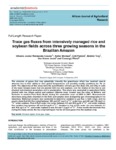Por favor, use este identificador para citar o enlazar este ítem:
http://www.alice.cnptia.embrapa.br/alice/handle/doc/1025759Registro completo de metadatos
| Campo DC | Valor | Lengua/Idioma |
|---|---|---|
| dc.contributor.author | OLIVEIRA JUNIOR, R. C. | pt_BR |
| dc.contributor.author | KELLER, M. | pt_BR |
| dc.contributor.author | CRILL, P. | pt_BR |
| dc.contributor.author | BELDINI, T. | pt_BR |
| dc.contributor.author | HAREN, J. van | pt_BR |
| dc.contributor.author | CAMARGO, P. | pt_BR |
| dc.date.accessioned | 2017-07-20T23:57:18Z | - |
| dc.date.available | 2017-07-20T23:57:18Z | - |
| dc.date.created | 2015-10-05 | pt_BR |
| dc.date.issued | 2015 | pt_BR |
| dc.identifier.citation | African Journal of Agricultural Research, v. 10, n. 39, p. 3748-3758, Sep. 2015. | pt_BR |
| dc.identifier.uri | http://www.alice.cnptia.embrapa.br/alice/handle/doc/1025759 | pt_BR |
| dc.description | The emission of gases that may potentially intensify the greenhouse effect has received special attention due to their ability to raise global temperatures and possibly modify conditions for life on earth. The objectives of this study were the quantification of trace gas flux (N2O, CO2 and CH4) in soils of the lower Amazon basin that are planted with rice and soybean, and the relation of this flux to soil physical and chemical parameters and to precipitation. This study was conducted in agricultural fields planted with rice (Oryza sativa) and soybean (Glycine max), located near the cities of Belterra and Santarém in western Pará State, Brazil, during the production years of 2005 to 2007. Measurements were done using static chambers in the field, and samples were analyzed by gas chromatography in the laboratory. Statistical analysis was conducted to determine variation in gas flux in both crops, and the results show that CO2 flux varied between 305 and 227 mg-C m-2 h-1 under rice, and 243 and 156 mg-C m-2 h-1 under soybean. Flux of N2O under rice varied between 4.5 and 20.4 μg-N m-2 h-1, and under soybean flux variation was between 4.0 and 9.4 μg-N m-2 h-1. Variation in flux of CH4 under rice was between 5.1 and 14.0 μg-C m-2 h-1, and under soybean it was 0.4 and 1.2 μg-C m-2 h-1. These results demonstrate that, during the study period, the rice crop had higher flux for all trace gases than the soybean crop. | pt_BR |
| dc.language.iso | eng | eng |
| dc.rights | openAccess | eng |
| dc.title | Trace gas fluxes from intensively managed rice and soybean fields across three growing seasons in the Brazilian Amazon. | pt_BR |
| dc.type | Artigo de periódico | pt_BR |
| dc.date.updated | 2017-07-20T23:57:18Z | pt_BR |
| dc.subject.thesagro | Arroz | pt_BR |
| dc.subject.thesagro | Soja | pt_BR |
| dc.subject.nalthesaurus | Amazonia | pt_BR |
| dc.subject.nalthesaurus | gases | pt_BR |
| riaa.ainfo.id | 1025759 | pt_BR |
| riaa.ainfo.lastupdate | 2017-07-20 | pt_BR |
| dc.identifier.doi | 10.5897/AJAR2015.10241 | pt_BR |
| dc.contributor.institution | RAIMUNDO COSME DE OLIVEIRA JUNIOR, CPATU; Michael Keller, US Forest Service; Patrick Crill, Stockholm University; Troy Beldini, UFOPA; Joost Van Haren, University of Arizona; Plinio Camargo, CENA/USP. | pt_BR |
| Aparece en las colecciones: | Artigo em periódico indexado (CPATU)  | |
Ficheros en este ítem:
| Fichero | Descripción | Tamaño | Formato | |
|---|---|---|---|---|
| COSMEGASES.pdf | 312,78 kB | Adobe PDF |  Visualizar/Abrir |









